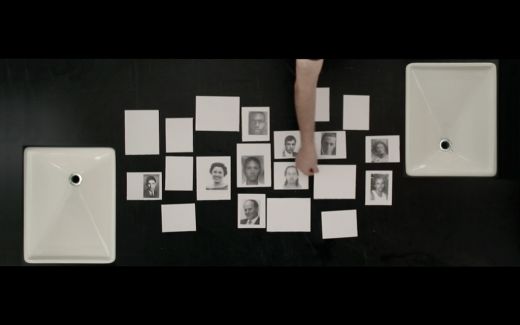Permission to be Global: Latin American Art from the Ella Fontanals-Cisneros Collection
Heather Diack

Oscar Muñoz, Sedimentations (Sedimentations), 2011. HD/BlueRay video projected onto table (black and white, sound). Courtesy of the artist and The Ella Fontanals-Cisneros Collection.
The exhibition consists of an impressive selection of works created between the 1960s and the present, by more than 61 artists from over a dozen Latin American nations, striking a balance between historic precedents and more contemporary manifestations. Divided by four convincing thematic sections, including “Power Parodied,” “Borders Redefined,” “Occupied Geometries,” and “Absence Accumulated,” the exhibition establishes specific points of reference for individual works while flowing compellingly between contexts.
A number of renowned artists are included, ranging from Ana Mendieta, Ernesto Neto, Lygia Clark, Francis Alÿs, Gabriel Orozco, and Lucio Fontana. This lineup of usual suspects is intermixed with work by artists who have not received as much attention on the world stage. Together they point suggestively to Latin American art as context more so than subject.
In this setting, ordinary objects take on new meanings inflected by their local origins while speaking to the question of whether being global necessitates submitting to globalization. In Marepe’s sculptural assemblage “Rio Fundo” (2004) four bottles of cachaça, Brazil’s popular sugarcane spirit, appear to float precariously atop a stack of pneumatic tires. Jac Leiner’s “Names” (1989) displays an accumulation of foam-filled Harrod’s shopping bags. Quilted together and seen within the context of economic exchange in São Paulo, Leiner’s collection of traces of the British conglomerate visually refer to the padded walls of an asylum, the logic of inflated economies, and, through its signature army-green color, connotations of a flak jacket.
A motif of gaps, holes, and in-between spaces also recurs. Daniel Medina’s “Reja naranja (dispositivo cinético-social)” (2012) is particularly striking. Employing the kind of iron security gate that is ubiquitous in Caracas, in rhythm with a series of painted chromatic stripes, Medina creates an optical illusion regarding the openness of space that is formally reminiscent of Carlos Cruz-Diez as much as Daniel Buren. The hinge of the piece, as with so many other works in Permission to be Global, is the emphatic degree to which content exceeds aesthetics. A threat to security is further implied by Cildo Meireles’ “Serie Descala 3a” (2002), in which a ladder featuring visibly broken rungs is adhered to the wall. In a confounding play that frustrates both upward and downward mobility, the binary of an impasse between North and South is implicated. Meaning is additionally cleaved by Eduardo Basualdo’s sharp “Finito” (2012), composed simply of a knife whose tip is split in two. The blade’s own internal division subtly ties together the seemingly divergent concepts of dividing and uniting.
References to artistic precursors are made both humorous and poignant throughout the exhibition. Take for example Gabriel de la Mora’s “F.B., 155 kilograms” (2011), from his series “Originalmente falso.” The piece, a heavy-set plain-faced slab of bronze, is in fact a melted work that had been falsely ascribed to Fernando Botero. Yaima Carrazana’s “Nail Polish Tutorials” (2010) furthers this theme with her presentation of short how-to videos precisely about imitation and imagined attribution. Each clip shows Carrazana recreating famous paintings by artists such as Frank Stella, Jasper Johns, and Kazimir Malevich, based on Google image search results. The Cuban artist’s choice of iconic artists speaks to both the masculinity and militarism that dominated the polarities of Cold War aesthetics, and the reduction of such paintings to the scale of a female fingernail is a powerfully ironic and defiant gesture.
More sobering and somber works engaging with issues of effacement and memory include Oscar Muñoz’s “Sedimentaciones (Sedimentations)” (2011) and Regina José Galindo’s visceral video, “¿Quién puede borrar las huellas? (Who Can Erase the Footprints?)” (2003). Muñoz asks the viewer to consider the instability and absences that construct history by displaying photographic portraits that paradoxically vanish within a simulated developing room. Galindo’s similarly affective piece is a performance that vividly commemorates the estimated 200,000 victims of Guatemala’s civil war (1960-1996). Showing the artist’s barefoot pilgrimage from the constitutional court to the national palace, Galindo’s procession is interrupted intermittently so that the artist can dip her feet in a basin of human blood.
Eloquent forms with evocative implications compose Permission to be Global. Hybrids of resistance and participation abound, suggesting the perennial difficulties involved with defining boundaries particularly considering the specificities and the entangled histories of Latin America. Curiously, the exhibition’s title itself is deliberately lost in translation, with the English not being directly interchangeable with the Spanish. “Permission” in this case, though unable to escape connotations of gatekeeping, highlights the persistent preoccupation of artists from Central and South America and the Caribbean with the realities of transmission and communication across geopolitical and cultural borders.










